Endless possibilities when building feature-focused projects
by jason_cramp | April 12, 2018 2:35 pm
By Bruce Riley
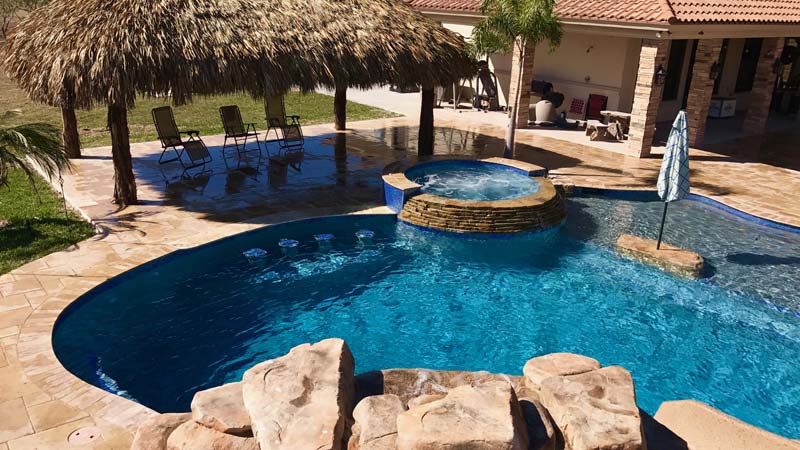 [1]
[1]So many options can be added to a pool these days that it can sometimes be overwhelming when deciding which ones to offer a customer. Every builder wants to fulfil their client’s desires, as well as exceed their expectations to ensure future referrals. To this end, it is important to design a project that can accommodate a number of different options to achieve the client’s idea of their ‘dream pool.’
This was the case for Kelly Norman of South Texas Pools in LaFeria, who recently built a third pool for a client and managed to incorporate multiple features to create their backyard oasis. From a custom water feature, slide, and swim-jet system to a large sun-shelf entry, raised spillover spa and a swim-up bar with ‘palapa’ (an open-sided dwelling with a thatched roof made of dried palm leaves).
To complete this project successfully, Norman made sure to define the client’s goals for their backyard, and relied on his experience to select a variety of unique features that would co-ordinate seamlessly with their home and property to give them the finished look they were after.
Defining the client’s goals
All pool builders understand the importance of interviewing the client before starting a project to determine what they want. In this case, Norman had worked with this client—over the span of 15 years—on two previous pools, so they were familiar with the each other; however, it did not make this project any easier. In fact, the client looked to Norman to present new, creative options that could be incorporated into the pool. Essentially, the client wanted a unique pool to suit different needs.
For this particular project, the homeowner wanted a pool their teenage children would enjoy, but had specific features for adults, too. This included options that would permit the pool to be used for exercise (swimming laps), as well as for providing entry-level scuba lessons. Further, there was a desire to have an eye-catching water feature, similar to one the client had on a previous pool. That said, the pool also had to have a natural look. To pull this off, Norman took clues from the client’s home, along with the country setting, to select the colour scheme and appropriate features to transform the backyard into an outdoor retreat.
Start with eye-catching elements
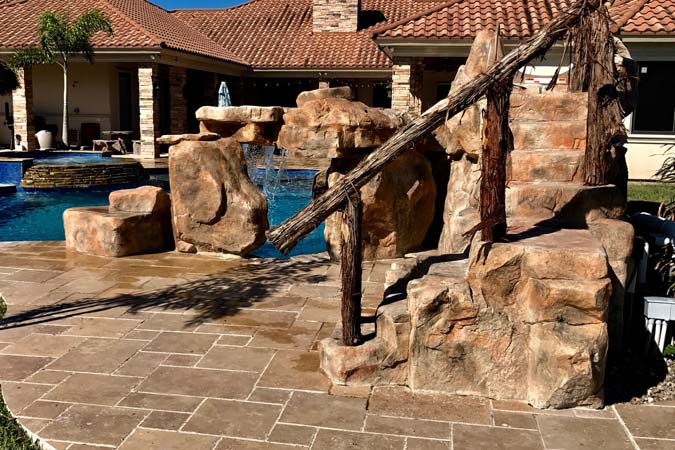 [2]
[2]As water features tend to be the focal point of a pool, it is best to base the design around these components. Whether it is a waterfall, grotto, or slide, it is important builders show the customer different options from previous projects or product catalogues, so they can quickly zero-in on the type of water feature that will define their pool’s overall design.
One of the previous pools Norman built for this customer had a large waterfall that was constructed free hand using natural stone boulders. While this gave that pool a striking look, the stone boulders available in the area where the new pool was being installed were comprised of sandstone and/or limestone composite. These boulders tend to wear down and, as a result, often leave debris in the pool in the form of dirt or sand. To remedy this, Norman introduced the client to another product—cast-concrete rocks.
One of the reasons Norman specified this product was because there were several prefabricated kits available to show the client. However, he was concerned it was going to be a hard sell and the client might reject this option because it was a manufactured stone. As it turned out, this option intrigued the client and liked the fact Norman was able to show a picture of what the finished product would look like.
In fact, many pool builders today are now offering prefabricated kit waterfalls, grottos, and caves specifically because they can offer a consistent, finished look for many different water features. Caves and grottos are essentially a super waterfall feature, as they provide all the benefits of a waterfall (visual beauty and the calming sound of cascading water), but also add fun and excitement to the pool—especially for children.
Unlike some artificial rock options that are cast from rubber moulds, new component systems look real because they are cast from actual rock, allowing them to take on the shape, character, and texture of natural boulders. As a result, it can be hard to tell the difference between real rock and cast-rock.
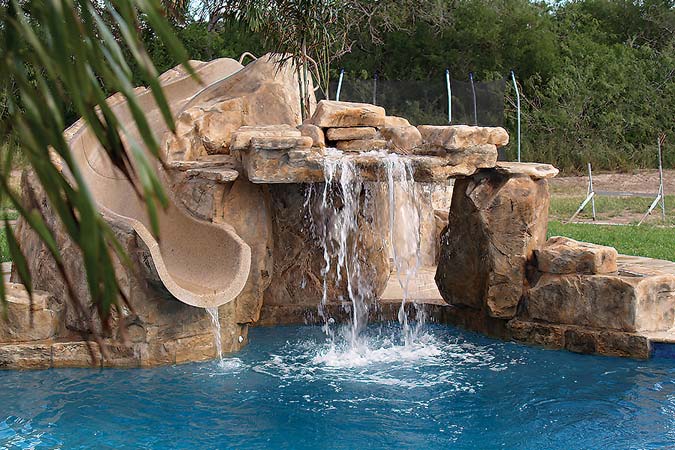 [3]
[3]Norman, being aware of these features, was comfortable in suggesting this option to his longstanding client who wanted to incorporate a natural stone feature on the new pool.
Unlike natural stone, these component systems are, in effect, a kit that allows builders to show their customers a brochure of what the final product will look like at the time they sell the job. When a builder orders a prefabricated kit, it comes complete with all the parts. Each system is built by assembling and fitting the parts together. From a builder’s perspective, the advantage of installing prefabricated grotto and cave water features is they are designed to ensure proper water flow and weight distribution. They are also reinforced with steel, which makes them structurally sound.
Not only is it important the finished look of the cave or grotto be predicable, but it is also critical the flowing water makes its way back into the pool. If the water does not return to the pool properly, it can get underneath the pool and cause problems. Water seepage through mortar joints and white calcium deposits are the most common problems that occur when water leaves the pool through a water feature. Water loss out of the backside of the feature can also occur, which is generally not acceptable to pool owners. This is one of the benefits of a component system, as they are designed to ensure water remains in the pool.
Once a natural waterfall leaks, it usually accelerates with time. In freeze-thaw regions, they will break apart and leak faster. Further, calcium deposits occur when water moves through the concrete and pushes out mineral deposits.
Creating a dramatic waterfall with rounded boulders can be difficult. In nature, one is used to seeing cascades with hundreds of thousands of gallons per minute (gpm) of water flow. In pool situations, however, the challenge is to make the most of a water feature using a flowrate under 378 litres per minute (lpm) (100 gpm).
Integrating the main features
For this project, the client wanted to incorporate a mini cave/grotto on the 7.3- x 9.1- x 11-m (24- x 30- x 36-ft) freeform pool. After seeing several photos in product catalogues, the client also wanted a 4.5-m (15-ft) garden-ride slide integrated into the rock feature.
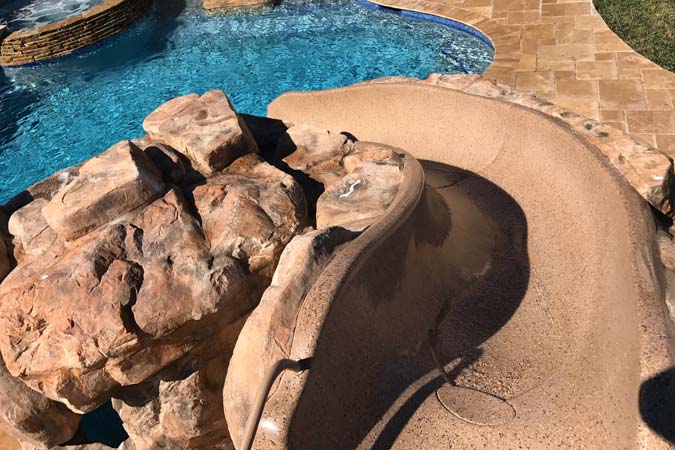 [4]
[4]After these features were defined, it became easier for Norman to offer additional options to meet the client’s goals. For instance, since the grotto and slide were to be the primary eye-catching elements on the pool, it was important they were strategically located in a spot where they could be seen from the home. To accomplish this, Norman took cues from the home and its doors to the backyard to maximize the visual impact of this feature, which was installed at the far end of the pool.
To ensure the slide and grotto could be enjoyed to the fullest, the pool was designed to be 2.4 m (8 ft) deep, which would allow kids to jump off safely from the grotto in addition to landing safely from the slide. When incorporating a slide into a grotto feature, Norman prefers to use a prefabricated slide, opposed to building one, as the sliding is safe and there are no rough areas to worry about. Pre-fabricated slides also come with a built-in water delivery system to ensure the surface remains lubricated for consistent, fun sliding. Beneath the slide is a stainless steel support structure, which makes it easy to build a composite rock feature around. The colour of the slide, which also has a granite texture to make it look like real stone, was selected to blend into the rock feature.
For hydraulics, Norman installed a single-speed, 2-hp pump with a three-way valve to divert pool water to the slide and water feature.
The addition of the slide also required the construction of a staircase for access. Manufacturers of component water features also offer systems that make it easy to build rock staircases. As was the case with this pool, building a modular staircase to access the slide can be completed in one day. The speed of installation is much faster than building a staircase system from scratch, which would generally take at least three to four days. Further, the labour savings alone make component systems extremely price competitive in the marketplace, not to mention attractive to builders as they enable them to stay on schedule and maximize their building season.
Creating water features with natural stone can often be unpredictable. Builders can spend all day arranging boulders only to have the client come home and ask to see the stones arranged in a different pattern.
Component water features offer the ability to control the cost of rock structures. Custom rockwork can easily go beyond the builder’s original quote because of the unpredictable nature of using natural stone.
Fun and functional
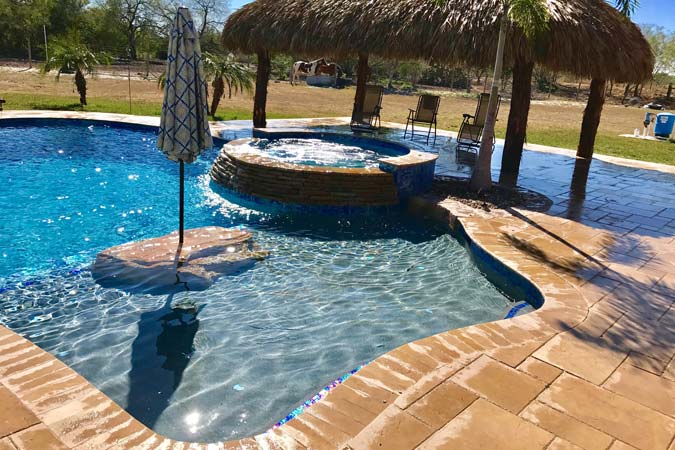 [5]
[5]To accommodate the other requests the client had, Norman installed a swim-jet system inside the sitting area of the grotto. When activated, it creates the appearance of water flowing across a stream, giving the pool the ‘look and feel’ of a natural swimming hole. Not only does the swim jet provide the current necessary for swim resistance, but also imitates the moving water that divers experience when scuba diving in the ocean.
The client’s previous pool had a beach entry; however, although it was fun and interesting, it was not practical for the family. Therefore, on this project, Norman designed a large, two-stage shelf pool entrance. The first shelf slopes slightly forward to the start of the second shelf, which is roughly 0.9 m (3 ft) deep. This design works particularly well for the scuba-diving courses held in the pool, as those in scuba gear can stand on the second shelf and lean onto the first shelf or put their tanks and other equipment on the second shelf, which is still in the water and within arms-reach.
The first shelf also provides a large area for sitting within the pool, similar to a sun shelf. To promote in-pool lounging, a rock platform was added along the edge of the sun shelf, which included a rock feature with an umbrella anchor as way to create shade in the pool.
Integrating a spa
 [6]
[6]Once the main water feature and slide were positioned on the pool, determining how to integrate a spa into the backyard was the next step. Adding a spillover spa can give a pool greater utility; however, when doing so, it is important to employ interesting contrasts, as well as balance. To accomplish this, each feature was installed on opposite ends of the pool. Further, by placing the spa closer to the home, and the grotto and slide furthest away, it added depth to the backyard.
By locating the spillover spa closer to client’s house, it allows adults to enjoy warm-water hydrotherapy, while children and teenagers play at the opposite end of the pool in the grotto and slide ‘zone.’ To create contrast, Norman suggested a raised spa with a stacked stone spillway. This material was selected as a continuation of the ‘natural’ look of the pool and its other features.
Creating social areas
To increase the functionality of the pool, a swim-up bar was also added which faces the yard where a ‘Palapa’ was installed. The water depth in the swim-up bar area is approximately 0.9 m (3 ft) deep and features custom, built-in stools.
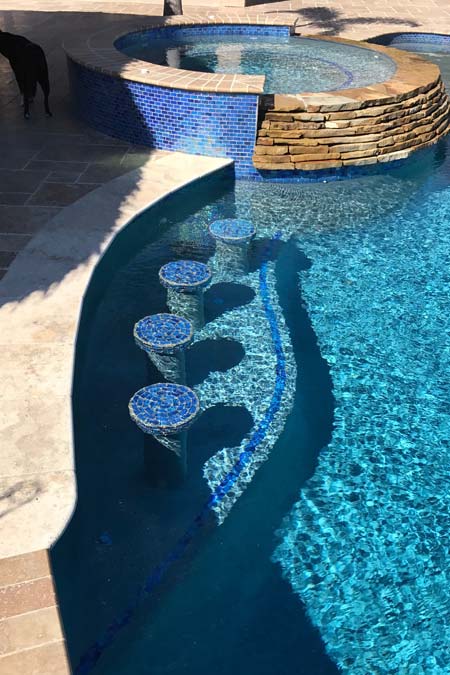 [7]
[7]Norman installed four concrete stools, each made using a Sonotube (roughly 203 mm [8 in.] in diameter), with a 305-mm (12-in.) concrete cap. The stools were finished with tile and positioned 0.6 m (2 ft) apart. The water is shallow enough so that, while sitting, it reaches just below the bather’s chest. The depth of the pool immediately adjacent to this area is approximately 1.8 m (6 ft) deep, allowing bathers to swim away after socializing at the bar. The bar was also located near the spa to create multiple social areas within the pool.
Look to the house for cues
To complement the natural characteristics of the pool, Norman installed travertine stone decking, finished with a classic walnut tile colour and texture. The stone decking contrasts with the pool’s deep blue interior, which was created using tile around the vertical walls of the pool perimeter, in addition to the spa.
To create one cohesive space, the ‘U’ shape of the home was also taken into consideration. As this area leads to the pool and, rather than leaving a large concrete void, Norman designed an additional feature as a way to link the outdoor living space to the pool.
Here, a small ‘water hole’ was installed that includes a water fountain, which is positioned close to the fireplace and dining area nearby the home. Water is pumped from the pool into the bubbling water feature to create soothing sounds for those sitting on the patio. It also features integrated light-emitting diode (LED) lights to offer a variety of effects. The water feature can be controlled separately from the pool’s features, allowing the homeowner to turn it on/off depending on their mood.
Do not overlook anything
Even if the client does not specifically ask for a cave, grotto, waterfall or slide, these features should be discussed as they can make a pool more esthetically pleasing, not to mention more fun. For builders, these features can also make a new pool installation or renovation much more profitable.
Many builders are leaving money on the table when they neglect to offer a suite of options that can be incorporated on a pool. This project is a prime example of how multiple features can be included on a single pool.
 [8]Bruce Riley is the managing director of RicoRock Inc., makers of cast-concrete rock, including component systems for building caves/grottos, waterfalls, and waterslide products for use in pool applications. Riley focuses on developing new products and managing commercial installations. He built rock-type pools in southern California for 25 years and now uses this experience to design standard waterfall kits for the company. He can be reached via e-mail at bruce@ricorock.com[9].
[8]Bruce Riley is the managing director of RicoRock Inc., makers of cast-concrete rock, including component systems for building caves/grottos, waterfalls, and waterslide products for use in pool applications. Riley focuses on developing new products and managing commercial installations. He built rock-type pools in southern California for 25 years and now uses this experience to design standard waterfall kits for the company. He can be reached via e-mail at bruce@ricorock.com[9].
- [Image]: https://www.poolspamarketing.com/wp-content/uploads/2018/04/FullSizeRenderG__Kelly.jpg
- [Image]: https://www.poolspamarketing.com/wp-content/uploads/2018/04/FullSizeRenderF__Kelly.jpg
- [Image]: https://www.poolspamarketing.com/wp-content/uploads/2018/04/1014472.jpg
- [Image]: https://www.poolspamarketing.com/wp-content/uploads/2018/04/IMG_1873__Kelly.jpg
- [Image]: https://www.poolspamarketing.com/wp-content/uploads/2018/04/FullSizeRenderL__Kelly.jpg
- [Image]: https://www.poolspamarketing.com/wp-content/uploads/2018/04/FullSizeRender2__SouthTexas.jpg
- [Image]: https://www.poolspamarketing.com/wp-content/uploads/2018/04/FullSizeRenderEE__Kelly.jpg
- [Image]: https://www.poolspamarketing.com/wp-content/uploads/2017/06/Riley_Headshot.jpg
- bruce@ricorock.com: mailto:bruce@ricorock.com
Source URL: https://www.poolspamarketing.com/trade/features/expert-advice/building-feature-focused-projects/